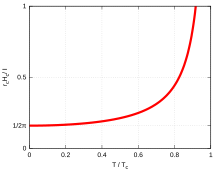Silsbee effect
The Silsbee effect , also known as the Silsbee hypothesis (after Francis B. Silsbee ), is the breakdown of the superconducting state at high currents in a type I superconductor, the radius of which is greater than the London penetration depth .
Derivation
The Ampère law describes the relationship between the current flowing in a wire power and the strength of the magnetic field generated by it . For a wire with a circular cross-section and radius, the following applies to the magnetic field on its surface:
- .
The dependence of the critical field strength on the critical temperature can be found empirically or derived from the BCS theory :
So for the critical radius of a superconductor through which the current flows at the temperature :
In this way, currents of up to 100 A can flow in a wire with a 1 mm diameter.
The critical current densities or the critical radius resulting from this simple calculation are only to be understood as an estimate. More precise calculations based on the Ginsburg-Landau or BCS theory can sometimes result in significantly lower values, especially if contamination and material defects are taken into account.
Individual evidence
- ↑ Max von Laue: Theory of superconductivity . 2nd Edition. Springer-Verlag, Berlin 1949, p. 6 .
- ↑ FB Silsbee: Electrical conduction in metals at low temperatures . In: Journal of the Washington Academy of Science . tape 6 , 1916, pp. 597–602 (English, electrical conduction in metals at low temperatures). Quoted from Max von Laue: Theory of superconductivity . 2nd Edition. Springer-Verlag, Berlin 1949, p. 6 .
- ↑ Werner Buckel, Reinhold Kleiner: Superconductivity - Basics and Applications . 7th edition. Wiley-VCH, Weinheim 2013, ISBN 978-3-527-41139-9 , pp. 290 f .
- ↑ Neil W. Ashcroft, David N. Mermin: Solid State Physics . 4th edition. Oldenbourg Wissenschaftsverlag, 2012, ISBN 978-3-486-71301-5 , p. 931 .
- ^ Rudolf Gross, Achim Marx: Solid State Physics . 2nd Edition. De Gruyter, Berlin / Boston 2014, ISBN 978-3-11-035869-8 , pp. 839 ff .










